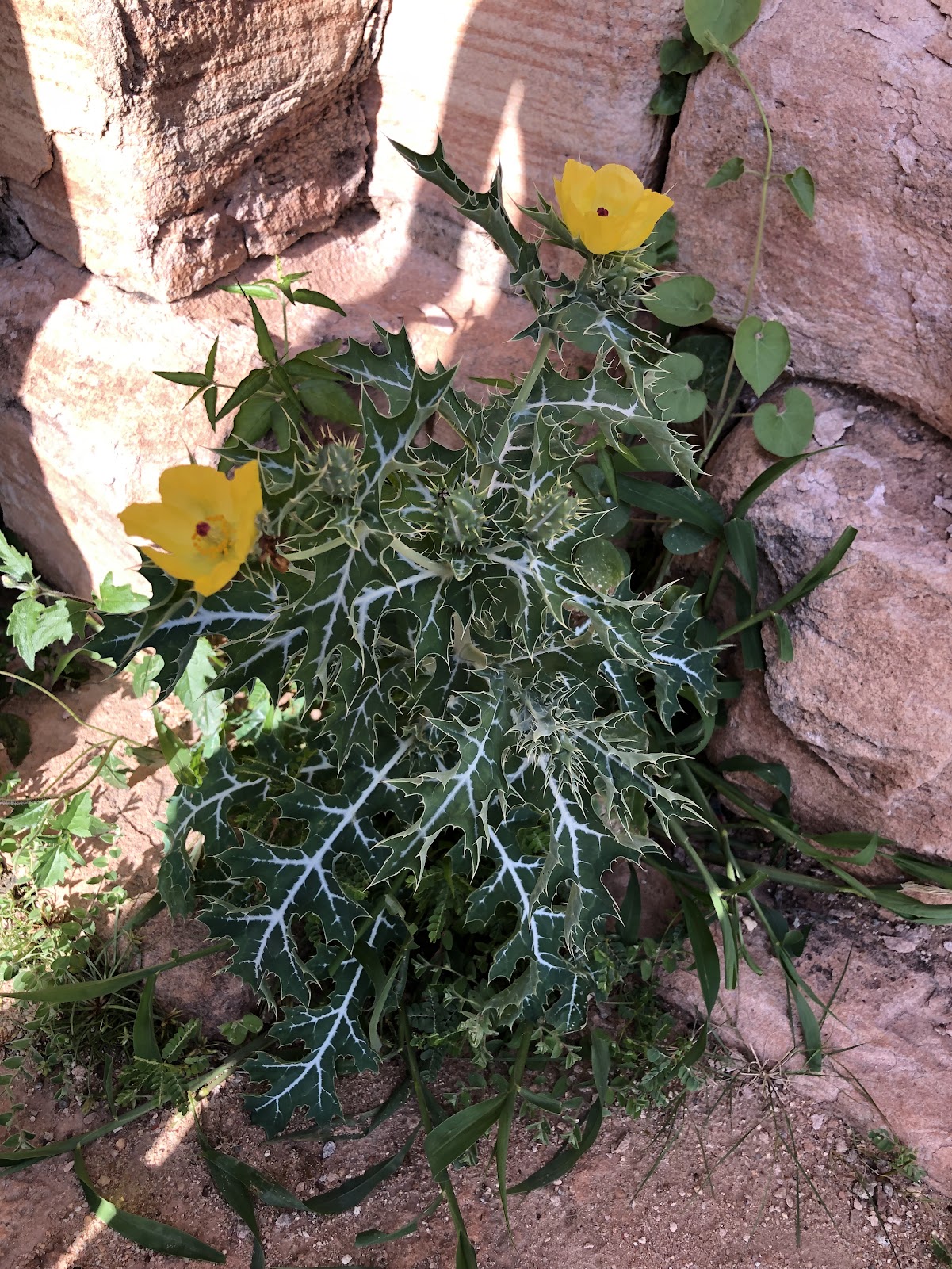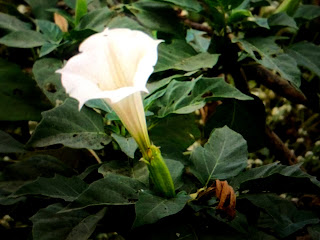- Sparrows
- Lizards: Household Geckos which were on the ceiling or on the walls inside the home (called halli in Kannada)
- Also a gecko which lived in my bathroom but which had white dots on it and was fatter than the usual geckos. I thought it may be a 'salamander' but according to wikipedia there don't seem to be salamanders in south India.
- Skinny grey lizards These were in my garden and outdoors on the roof, outdoor walls on the house.(All types of lizards are called Votiketta in Kannada) They were almost invisible against the unpainted cement of my home
- Lizards with the spiky growth along neck and back;
- Lizards which were mostly black and were streaked with bright colours like red, orange and yellow. These were bigger i.e. broader and longer than the other lizards.
- The shiny and wet looking lizard called as Hav-rani in Kannada. Responding to a reader's comment, the Hav-rani is called snake-eyed skink, which is a species of lizards found in many countries and there are 35 types of these snake-eyed skinks (Googled it!)
- Snakes:Cobras which have entered my house on more than one occasion in parts of Bangalore which are now densely populated by people. So we don't see snakes as often in Bangalore now.
- Grey frogs
- Plump earthworms...but not as plump as the Canadian earthworms I find in my Toronto garden now
- Bats
- Squirrels
- Butterflies & moths
- Green and brown grasshoppers
- Several insects I cannot name such as a thin leggy insect which could skate on water, an insect which came in large numbers after rains and flew round and round the street lights, etc.
- Tailor birds(This one would stitch a nest out of two leaves of the brinjal plant which grew in front of our garage)
- Dragonflies
- Blue kingfishers near water bodies such as Hebbal lake and so on.
- Purple moorhens at the Puttenhalli kere.
- Paradise flycatcher in University of Agriculture campus near Hebbal lake(I was so overjoyed to see this bird with a long tail feather floating at the back! It's so depressing now to see the lake eaten away by roads and people...the noise level enough is enough to kill off the other living creatures around this area)
I do not see any of the above these days i.e. 2010 onwards. The non-human life(excluding plants) I see in urban Bangalore today include dogs, cats, cockroaches, mosquitoes, crows, black and red ants(ants in houses). Maybe my list would be longer if I could recall better!
I am saddened to see so much of animal, insect and reptile life missing from urban Bangalore. Thanks to increasing takeover of the city's green earth by man, there isn't an inch of space left for other living creatures!
One example of man's ruthless domination of urban space is of people destroying nests in houses, outside houses as they think it 'looks shabby'. They poke out these nests with long sticks if they cannot reach them, without a thought for the birds or their eggs & young ones.
I have seen people screaming with fear and killing lizards and house- geckos as if they were dangerous bandits. It burns me up, but hey, what can I do? Bangalore is full of Educated BUT Ignorant idiots! The first rankers of these ignorant idiots is of course our politicians who allow all the green earth and lakes of Bangalore to be built over, simply to fill their personal coffers.
Another set of Bangaloreans who annoy me are those who build and cover with concrete every single square inch of land on their site! There is no uncovered earth, for the rain water to go in and replenish the ground-water.
I also hate the Bangaloreans who don't want 'dead leaves dirtying' their 'clean-swept' concrete. My dad's neighbour is one such person, who constantly fights with my father about the leaves from our garden.
I had this conversation with a friend who lives in Bangalore this year(2016).
Me: It's so hot and no water around for the birds. Why don't you place a bucket of water on the rooftop of your apartment building daily?
Friend: Yes. I will ask the security to do it. Umm. I don't think my husband will let me talk to the security to ask him to do this daily.
M:Why don't you do it yourself?
F:What ?Me? My husband will kill me. I can't go daily with a bucket to the apartment roof. People will think I am mad!
People's obsessive need for appearing clean, spruced up and shiny makes them take long poles and poke out the nests built by birds in their building's nooks and crannies.
People have zero tolerance for anything which clashes with their urban cleanliness. They don't want birds nests as they are messy; they don't want birds flying near their homes as they don't want bird shit;
They don't want lizards or geckos as they 'may fall into open food vessels and they will die if they eat that food', they don't want owls or bats around their area as it's bad luck to see them, and so on and on and on.
A paradoxical behaviour of Indians/Bangaloreans/Hindus is the worship of cobras i.e .the sculptures of cobras in temples and on festival days such as Nag-Panchami but also beat a snake to death with sticks the moment they spot one! Even tiny baby snakes are not spared.
A similar worship-cum-cruelty is the reverence & worship of cows as they are considered to be Gods and the simultaneous mistreatment of bull-calves (born in the cities) by starving them as they are 'not useful'. The bull calves born in villages don't face similar fate as their unfortunate city-born brothers as they are 'useful' for ploughing in the fields. Personally, I think it's less cruel to kill the calf with one stroke then let it roam the city without feeding it and die a slow painful death by starvation & dehydration.
In the 70s and earlier, people had space for gardens in homes. Now every inch of land is built over and covered with concrete, leaving no earth for the plants to grow; With plants absent, there's no resources for insects and birds and reptiles to survive. The food chain for all these creatures is brutally cut and Bangaloreans and the politicians of Karnataka forget that this will ultimately lead to death of Bangalore itself.
-------------------------------------------------------------
The plants I NO LONGER SEE TODAY BUT I had seen growing wild in Bangalore in the past...by wild I mean that I had seen these plants growing on pavements, in empty sites, in people's houses, etc
bili-tumbe-hoovu (white tumbe hoovu) whose botanical name is Leucas Cephalotes(roth)spreng
Tumbe hoovu(pink )
Red tumbe hoovu
Milk weed(It had silky hair-like stuff attached to it's seeds)(Giant milkweed or swallow-wart)
Another is a plant which was used as borders or fences between houses with tiny red-pink flowers,growing in bunches. This plant's leaves were pretty rough textured.. I see this plant in Canada in pots as an ornamental plant. Lantana Camara
Another plant I don't see these days in Bangalore is a weed with lovely yellow flowers & thorny bluish leaves (http://floraandhrika.blogspot.ca/ gives information about this yellow flower plant called Argemone Mexicana).For some reason thoughts about this weed have nagged me on and off for the last many years. I even looked out for it during my 2016 visit to Bangalore and din't find it anywhere. I am glad I finally found it's name and details in this webpage(invasive plants of India pdf) at least now in July 2016! Finding this plant was like getting out an elusive piece of food stuck in your teeth after hours of trying to get it out with your tongue! and I found this blue-leafed yellow flower weed plant near Gadag during a 2019 visit. It was growing near one of the thousand year old temples near a village in Gadag.

This is the weed I saw near temple in Gadag...which is missing from the pavements of Bangalore these days.
Another is a weed with white bell shaped flowers and thorn covered fruit.(possibly Datura Stramonium)
Another was a blue bell shaped flower weed plant, growing lightly like a creeper and spreading all over the ground and fences.(Clitoria ternata) Also called Vishnu Kranti and Shanka pushpa
Another was morning glory or Ipomea flowers
Another was a plant with yellow flowers, growing on the fence of the stone building school near Malleshwaram bus stand(near Sankey tank) in the early 70s!
Another was a weed with bright yellow flowers and leaves like the groundnut plant's.
How could I forget the 'touch me not' plant (Mimosa Pidica)whose leaves magically close when touched! This too was a weed growing randomly around Bangalore, I would love to have this plant here in Canada and show off to kids!
I feel bad that these weeds have gone missing from Bangalore....they may be 'mere' weeds but still... they are pretty! The bright weed flowers on the concrete pavements have a pleasant effect on one's conscious or subconscious of pedestrians. It is high time Bangalore builders stopped pouring concrete over the entire Earth surface of Bangalore and give some space to plants to root!
http://www.isws.in/invasive-plants-of-india.php
is an excellent reference if you are looking for weeds of India. It has pictures which helped me to recognize what I was looking for.
....
Celosia argentea was a weed in the crops in my village. it was sold outside temples in the taluk as offerings to the Gods.
Chloris Barbata is another weed I recognize but cannot remember if I saw it in villages or cities in India
Cortalaria Retusa
Cryptostegia Grandiflora
Cuscuta Reflexa
Datura Innoxia
Datura metel but the flower color I have seen is different from the one I saw in the link above
Ipomoea Obscura
Mirabilis Jalapa
Opuntia Stricta (Not sure if I saw this cactus as a weed growing in villages or as a potted plant in homes in cities)
Tridax Cocumbens --I remember this tiny yellow flower so well!
Eicchornia Crassipes (I have seen this in Hebbal lake of India)
While reading about these plants in India, I was puzzled and I still have no answers. Majority of these plants came to India from other countries like Brazil according to what I read about them in wikipedia, etc.
Then which plants and trees, are true natives of India?
When I read books on Hindu customs and rituals, so many flowers, plants & trees mentioned in Hindu mythology don't seem to have been in India during Vedic times. How can this be explained?
Going back to the title of this article, I am depressed, angry and frustrated about the state of Bangalore at present.
One day our children will have to see the common sparrow (of the 70s) in zoos !
Bangalore is NOT DEVELOPING.
Bangalore is being MURDERED by people.
While reading about these plants in India, I was puzzled and I still have no answers. Majority of these plants came to India from other countries like Brazil according to what I read about them in wikipedia, etc.
Then which plants and trees, are true natives of India?
When I read books on Hindu customs and rituals, so many flowers, plants & trees mentioned in Hindu mythology don't seem to have been in India during Vedic times. How can this be explained?
Going back to the title of this article, I am depressed, angry and frustrated about the state of Bangalore at present.
One day our children will have to see the common sparrow (of the 70s) in zoos !
Bangalore is NOT DEVELOPING.
Bangalore is being MURDERED by people.



